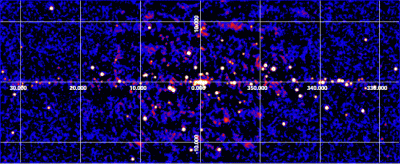I am writing this post following a thread that I started over a year ago about a topic that I am very fond of: the electromagnetic spectrum, which I believe is (unfortunately!) not a widely understood concept. ever since I wrote that post, I wanted to spend a few words and explain what all the fuzz is about - but of course I never had time for that...
then, a few months ago, I had the chance to write a story about ALMA, a world-class radio telescope, and since the story was supposed to be addressed to school kids, I thought - what a cool opportunity to try and explain this topic once and for all... so I convinced the editors of Science in School to have a separate box about it. space on the magazine is always scarce, but I tried to do my best - in less than 200 words!! Detecting astronomical objects along the electromagnetic spectrumVisible light is just a small part of the whole spectrum of electromagnetic radiation. The different parts of the spectrum, or spectral bands, are, in order of decreasing wavelength and increasing frequency: radio waves (including microwaves and (sub)millimetre radiation), infrared, visible, ultraviolet, X-rays and gamma rays.
Because different physical processes in the Universe emit light at different wavelengths, each class of objects in the Universe shines most brightly in one or several particular spectral bands. Modern astronomers often try to target many bands, using different telescopes, since each set of observations provides a complementary piece of the puzzle; this approach is called multi-wavelength astronomy.

However, Earth’s atmosphere complicates matters, because it absorbs most of the radiation. Although this protects us, it makes life difficult for astronomers: only a tiny fraction of the electromagnetic spectrum is observable from the ground, and often in these cases, the quality of the observations strongly depends on the geographical site. This is why choosing an excellent site such as Chajnantor for ALMA is so important. In other spectral bands, especially at very short wavelengths, astronomers need telescopes aboard satellites in orbit around our planet, outside the obscuring layer of the atmosphere.
---
The image above displays the atmospheric opacity - the level of the brown curve represents how opaque the atmosphere is at the given wavelength. The major windows are at visible wavelengths (marked by the rainbow) and at radio wavelengths from about 1 mm to 10 m. Observations at wavelengths where the atmosphere is opaque require space telescopes.
Image credits: ESA/Hubble/F.Granato
 For almost 15 years, the EIT camera on board SOHO transmitted a picture of the solar corona every 12 minutes, providing ground-breaking observations of the Sun that changed our perception and understanding of our star. After a remarkable career, this instrument has now eased into semi-retirement. Although no longer as active as during its heyday, EIT will still provide snapshots of the Sun - at a more leisurely pace. More...
For almost 15 years, the EIT camera on board SOHO transmitted a picture of the solar corona every 12 minutes, providing ground-breaking observations of the Sun that changed our perception and understanding of our star. After a remarkable career, this instrument has now eased into semi-retirement. Although no longer as active as during its heyday, EIT will still provide snapshots of the Sun - at a more leisurely pace. More...





